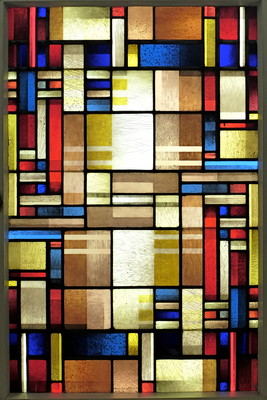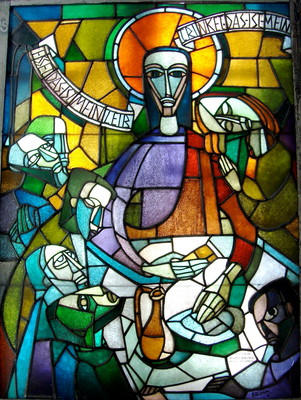August Wagner (1866-1946)
August Wagner was the founder in 1889 of the Deutsche Glasmosaikanstalt Puhl & Wagner, in Berlin-Rixdorf (now Neukölln).
In 1904, a new factory building was constructed to plans by the ‘imperial architect’ Franz Schwechten (1841–1924), who also created the Anhalter Bahnhof (formerly the main railway terminus in Berlin) and the Kaiser-Wilhelm-Gedächtniskirche. Kaiser Wilhelm II donated the furnace chimney, which dominated the whole complex and was in the form of a huge Romanesque column, complete with capital, totally covered in glittering gold mosaic. Around this time, the firm also executed the mosaics for the Kaiserbrunnen (‘Imperial Fountain’, now known as the ‘German Fountain’) in Constantinople (Istanbul); for the façade of the Königliche Biologischen Anstalt (‘Royal Biological Institute’) on Helgoland; and for the court façade of the famous Hotel Adlon in Berlin.
In 1914, the firm joined forces with Gottfried Heinersdorff (1883–1941), who at the time already had an excellent reputation in the field of contemporary glass-painting and for his contribution to its renewal. The crucial reason for August Wagner’s offer to join forces was the development of gold and silver smalts, a process that was both novel and extremely promising. The process – whereby exceptionally thin gold or silver leaf was fused inside the mass of the glass – was patented in 1905.
After the First World War, the firm countered the fall-off in the number of commissions by opening daughter firms in the USA and taking on commissions from abroad. Large commissions, such as those for the furnishing of the Hotel Excelsior at the Anhalter Bahnhof in Berlin and providing the mosaics for Europa and Bremen (ships of the Hapag Lloyd company) secured the firm’s reputation over many years. Despite limitations on production, work continued throughout the First World War. The imperial state commissions dried up of course, but their place was taken by new commissions from industry and other private clients. Even during the war, the Berlin art dealer Wolfgang Gurlitt (1888–1965) had his gallery on the Potsdamer Straßer furnished with glass doors to designs by Cesar Klein (1876–1954); two years later a joint commission with Max Pechstein (1881–1955) followed for the windows of his private residence. Later still, there were commissions for Wagner with Joseph Albers (1888–1976) and Cesar Klein for the Grassimuseum in Leipzig.
The productive collaboration between Puhl & Wagner and Gottfried Heinersdorff ended in 1933, when Heinersdorff had to withdraw from the firm on account of his jewish ancestry. Providing the decorative backdrop for the national socialists’ Thousand-Year Reich again brought the firm a large number of state commissions. After the Second World War, the firm did not recover and had to close its doors in 1969. An attempt to start again in Austria failed. In 1972, the factory was demolished in scandalous circumstances.
Links


